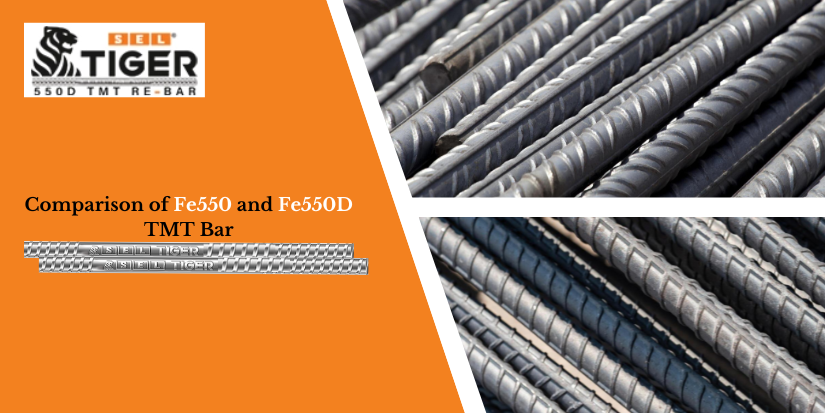
India’s rapid development towards a $5 trillion GDP is intricately linked with the construction industry. The surge in construction projects, spanning metro rail routes, bridges, flyovers, dams, and high-rise buildings (commercial and residential projects), underscores the pressing demand for high-quality construction materials. One such construction material known as the backbone of modern construction is the TMT bar. These rebars are manufactured with heat tempering exuding features such as ductility and strength-essential attributes to ensure the durability of construction endeavours.
In TMT bars, a range of grades are available such as Fe 415, Fe 500, Fe 550, Fe 550 D and Fe 600. Among them, Fe 550 and Fe 550D are the most widely used TMT bar grades for upscale construction, including flyovers, bridges, high-rise buildings, etc. As both of these grades are known for their exceptional features, a common question that most builders and contractors are concerned about is what the difference is.
Well, as an industry leader, we are here to clear the air around both of these TMT bar grades and with SEL Tiger TMT insight, we are ready to answer the difference between the Fe 550D TMT bar and the Fe 550 D TMT bar. So, next time you go to your TMT bar supplier you know which one to ask for!
Fe 550 TMT bar is one of the variants of the TMT bar grade, mostly used in high-rise construction, and has superior yield strength. “Fe” refers to Ferrous ore, which is the raw material of the TMT bar, while the number “550” refers to the yield strength of this TMT bar (Yield Strength is the maximum strength a steel can endure beyond which it begins to permanently deform). These rebars have higher flexibility and are known for reinforcing concrete structures in multi-storey construction.
Note that, Fu (ultimate tensile strength) represents the maximum stress that a material goes through while being stretched before it breaks. This is the point where the material experiences failure due to pulling.
Fy (yield strength) points towards the strength at which the material starts to distort plastically. In simple words, the TMT bar starts to deform without going through an increase in load.
The Fe 550D TMT grade bar is a type of Thermo-Mechanically Treated reinforcement steel bar that follows specific standards set by the Bureau of Indian Standards. As we know Fe stands for Iron, which indicates the primary element of the bar. The ‘D’ stands for ductility which is present in the TMT bar. It can deform without getting any cracks and provides boosted resilience and flexibility.
However the specifications of both the bars slightly differ. Here are the mechanical properties that Fe 550D TMT bar manufacturers attain through various processes and quality testing during TMT bar manufacturing.
Fe 550
Fe 550D
Fe 550
Fe 550 grade TMT bars are known for their earthquake resistance due to their high yield strength, which makes them an integral choice among engineers for high-rise construction such as sky-scrapers that include both commercial and residential properties.
Fe550D
Look for a registered Fe 550 D TMT bar supplier if your project requirements need a TMT bar that combines both strength and ductility. As mentioned earlier in the blog, “D” represents ductility, signifying that Fe 550D grade is the ideal choice for the construction of flyovers, skyscrapers, dams and bridges that demand materials with high impact resistance.
You can check: TMT Bars Price List
As we conclude, it is quite evident from the blog that Fe 550 and Fe 550 D both have similar properties and the differentiating factor between these is the presence of ductility in Fe 550D grade TMT bars. Be it high-rise construction, or civil construction such as bridges, railways, or flyovers, having better ductility helps in better impact resistance and helps in combating natural disasters such as earthquakes. In modern construction, Fe 550D is preferred over Fe550 TMT bars. Being the leading Fe 550 D TMT bar we make sure the quality meets and exceeds expectations through our rigorous testing process that includes bend and re-bend tests.
The primary difference is in their minimum yield strength. Fe 550D has a higher minimum yield strength when compared to Fe 550, making the bar suitable for application.
It depends on the structural requirements. If the design specifies a minimum strength, it’s crucial to use TMT bars that meet or exceed that requirement.
Fe 550 TMT bars have a higher minimum yield strength when compared to lower-grade bars (e.g., Fe 500, Fe415), making them suitable for applications where enhanced strength and load-bearing capacity are required.